|
Subpage flies:
Tachinidae
Blow-flies
(Calliphoridae) House
flies (Muscidae) Soldierflies
(Stratiomyidae)
Root-Maggot
Flies (Anthomyiidae) Small
flies Gnats
 Nederlands /
Dutch Nederlands /
Dutch
Root-maggot
flies (Anthomyiidae)
| Root-Maggot Flies
(Anthomyiidae)
Greek: anthos = flower en myia = fly
There are many species in our garden.
Characteristic: Small slender flies. Different colours. From yellow to
black.
Usually they are difficult to determine from a photo. Length from 4 up to 12 mm.
The wing vein M1 is straight and the anal vein long.
They feed on nectar and pollen but there are also predaceous species on
small flies.
When you want to see more species, you can look here.
The larvae are feeding on plants or decaying organic
matter. Sometimes they are miners.
German: Blumenfliegen
|
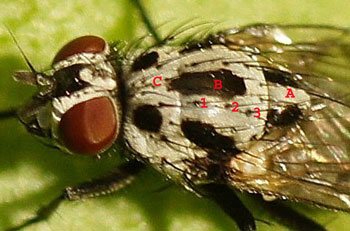 Anthomyia procellaris. Family Root-Maggot Flies (Anthomyiidae).
Anthomyia procellaris. Family Root-Maggot Flies (Anthomyiidae).
|
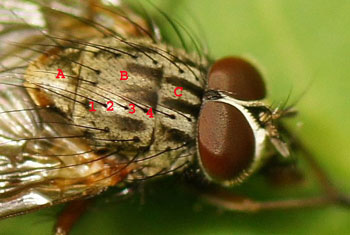 Phaonia errans.
Family House
flies (Muscidae).
Phaonia errans.
Family House
flies (Muscidae).
|
| A = scutellum B = scutum
C = prescutum
1, 2, 3 / 1, 2, 3, 4 = dorsal central hairs.
Difference between Root-Maggot flies (Anthomyiidae) and
a house flies (Muscidae). The flies in these two families are quite similar. An important difference is that the
root-maggot fly never has more than three dorsal central hairs on the scutum,
while the house fly has three or four central dorsal hairs. |
There are two important subfamilies. Anthomyiinae and Pegomyinae. These
subfamilies are divided into tribes.
Subfamily Anthomyiinae.
Tribe Anthomyiini.
 .. ..
 . .

Botanophila seneciella. Tribe Anthomyiini.
Onderfamilie Anthomyiinae.
Subfamily Anthomyiinae. Family Root-Maggot Flies
(Anthomyiidae).
In the ragwort flowers you often see "foam
cups". Under the foam are eggs of a fly. This time I saw also a fly. From a photograph
it was not possible to identify the fly well. But I think this fly had laid
the eggs on the flower.
I have sent some flower heads to Joke van Erkelens. In the flowers the
eggs were already hatched into larvae. She hoped the larvae would
pupate and change in a fly. That is not easy, because they overwinter as a
pupae. The pupae should not be too warm, not too humid, not too dry.
This year (2013) she has got one fly (a male). To the genitals, she could see, that it was a Botanophila seneciella. That's why I
think the fly in the picture is also a Botanophila seneciella.
Photos 36-7-2012. Here more
information in Dutch
|
 .. ..
 . .

Hylemya nigrimana /
Hylemya vagans. Tribe Anthomyiini. Subfamily Anthomyiinae. Family Root-Maggot Flies
(Anthomyiidae).
The photos are not so clear. Therefore I'm not
entirely sure. Hylemya nigrimana and Hylemya vagans are very
similar. |
Tribe Chirosiini.
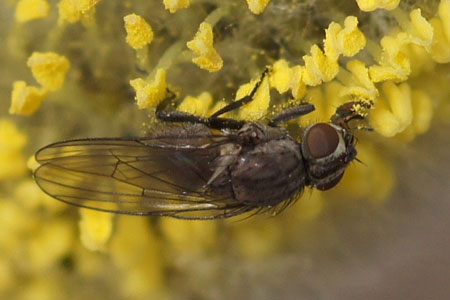 .. ..
 . .
 . .
 . .

Egle spec. Tribe Chirosiini. Subfamily
Anthomyiinae.
Family Root-Maggot Flies (Anthomyiidae). Not in the garden, because there are no willows around, but in the dunes about 4 miles from our house.
The flowers in the picture are of a willow. There you can find these
small flies in spring. Most Egle species are very small. They have long palps and a protruding underside of the head. Especially the males. But that is not visible when you see
these small flies on the willow. There are also slightly larger species. Many Egles are not to identify from a photograph.
The larvae are found in the seed pods of the willow. They pupate in the soil. There are now 10 known species in the Netherlands.
Photos 31-3-2014.
|
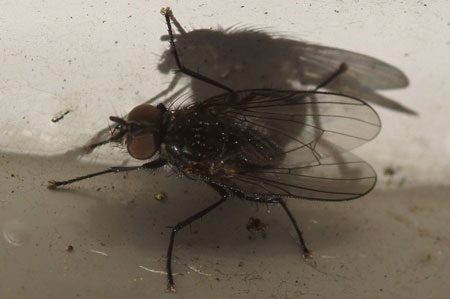
Lasiomma spec. Tribe Chirosiini. Subfamily
Anthomyiinae.
Family Root-Maggot Flies (Anthomyiidae).
Lasiomma species are often very similar. Here an example. Photo 7-3-2011. |
Tribe Hydrophoriini.
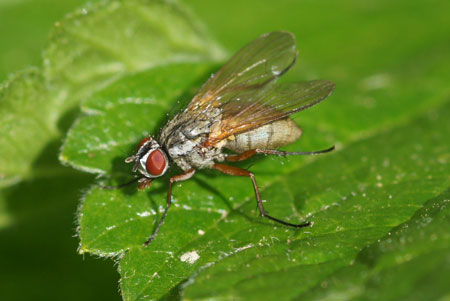 .. ..  . .

Hydrophoria linogrisea. Tribe Hydrophoriini. Subfamily
Anthomyiinae. Family Root-Maggot Flies (Anthomyiidae).
I haven't found much information.
|
 .. .. 
Eustalomyia hilaris. Tribe
Hydrophoriini. Subfamily Anthomyiinae. Family Root-Maggot Flies
(Anthomyiidae).
A white, blue fly. On the thorax a black stripe and black spots. The legs are dark. The Arista is long haired.
This fly came out of a hole in the bee hotel. Like the Leucophora obtusa the larvae of this fly are a parasite of the larvae of bees.
Photos 4-7-2012. |
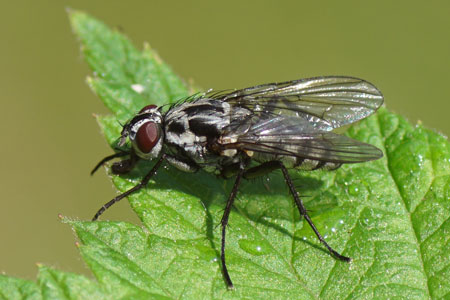 .. ..

Eustalomyia histrio.
Tribe Hydrophoriini. Subfamily Anthomyiinae. Family Root-Maggot Flies
(Anthomyiidae).
Niels-Jan Dek thanks for the identification. It lacks the blue hue of E. hilaris. Three species occur in the Netherlands. The third species is the Eustalomyia festiva. According to Niels-Jan, these are the differences:
The differences are the number of av setae on the hind tibia and the length of hairing of the arista.
Photos 18-5-2024. |
Subfamily Pegomyinae.
Tribe Myopinini
 .. ..
 . .

Calythea nigricans. Tribe
Myopinini. Subfamily Pegomyinae. Family Root-Maggot Flies
(Anthomyiidae).
A small fly, which nevertheless strikes by the comparatively large eyes and the gray spots on the back and abdomen.
It is not often photographed in the Netherlands. I did not find much information.
Photos 11-4-2011. |
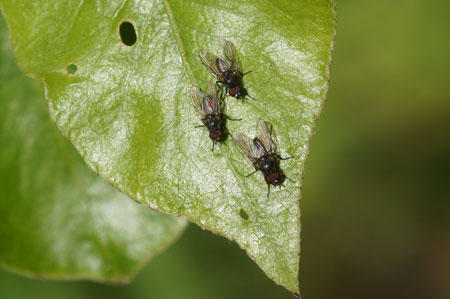 .. ..  . .

Pegoplata spec. Tribe Myopinini.
Subfamily Pegomyinae. Family Root-Maggot Flies
(Anthomyiidae).
In May there were many in the garden. Especially in the pear tree.
They are small flies. About 5 mm. Photos 10-5-2010. |
Tribe Pegomyini.
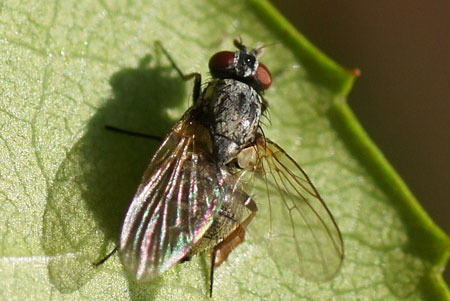 .. ..
 . .

Emmesomyia socia.
Tribe Pegomyini. Subfamily Pegomyinae. Family Root-Maggot Flies
(Anthomyiidae).
It can also be Emmesomyia grisea.
The difference with the females are the hairs on the posterior rear thigh (E. grisea
has these hairs. E. socia has not) Thanks to Joke and Niels-Jan.
When it saw me, it hide itself on the underside of a leaf. I still succeeded to
take a few pictures.
The shins are light brown. The wings have a light brown tint.
Photos 21-10-2011.
|
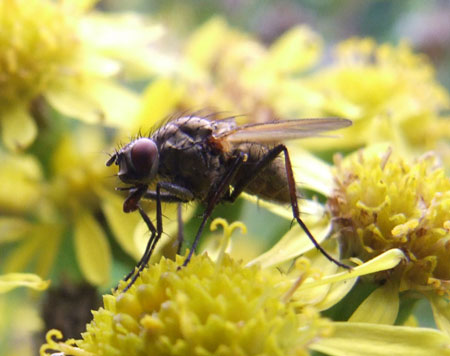
Pegomya spec.
Tribe Pegomyini. Subfamily Pegomyinae. Family Root-Maggot Flies
(Anthomyiidae).
The larvae seem to cause "foam cups" on Common Ragwort.
Photo 22-8-2008.
|
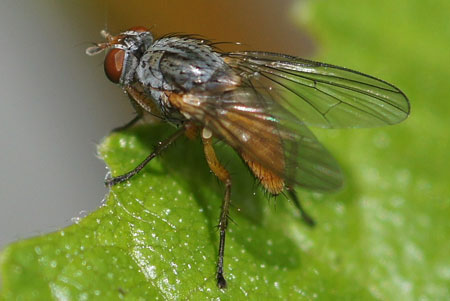 .. ..
 . .

Pegomya winthemi. Tribe Pegomyini.
Subfamily Pegomyinae. Family Root-Maggot Flies
(Anthomyiidae). Photos 30-8-2010. |
Nederlands /
Dutch
 
Subpage flies:
Tachinidae
Blow-flies
(Calliphoridae) House
flies (Muscidae) Soldierflies
(Stratiomyidae)
Root-Maggot
Flies (Anthomyiidae) Small
flies Gnats
Subpagina wespen, bijen, hommels: Parasitica, Ichneumonidae
Sawflies
symphyta Bumblebees
Bee hotel
|
